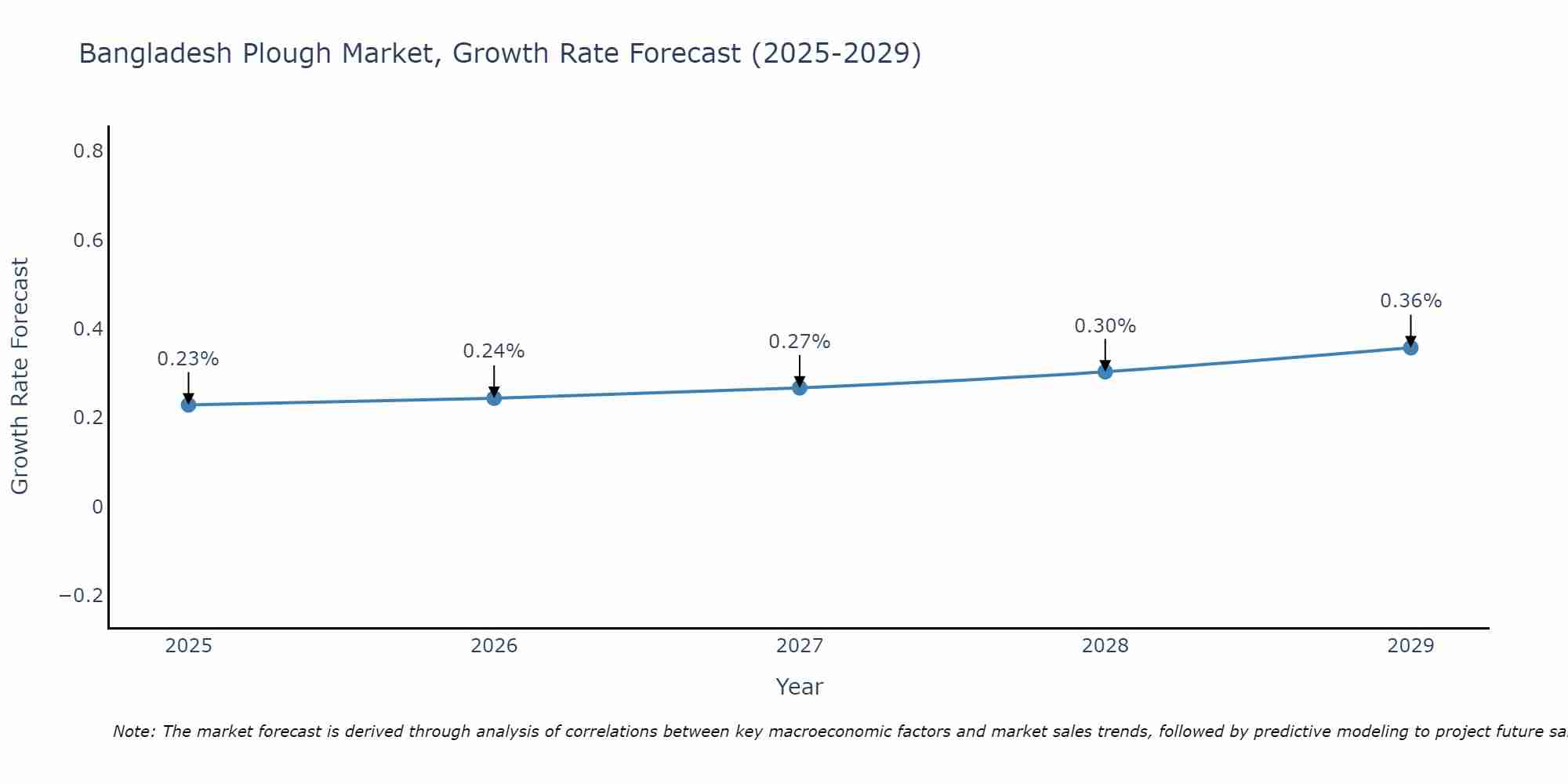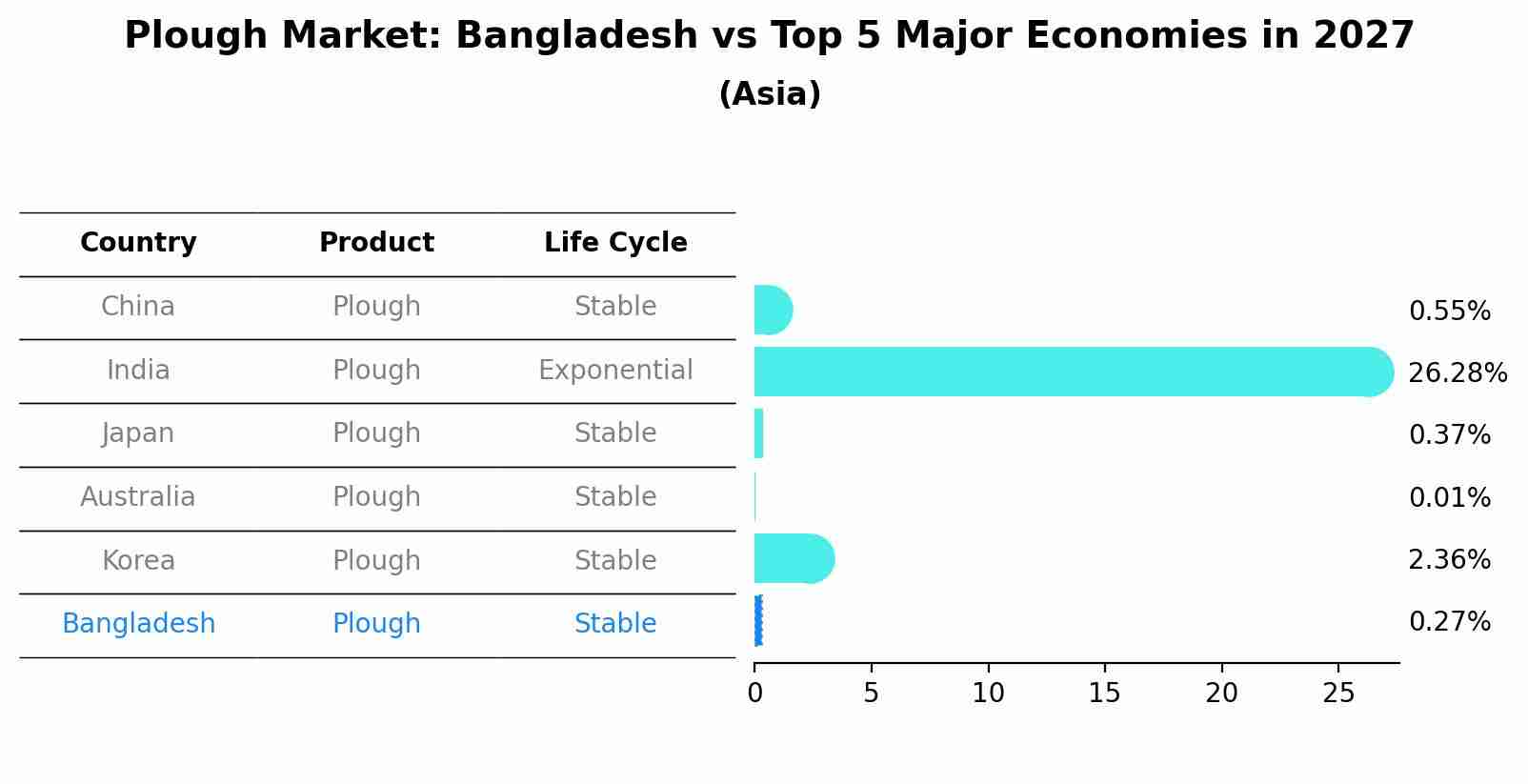Bangladesh Plough Market (2025-2031) | Forecast, Companies, Trends, Growth, Industry, Analysis, Revenue, Value, Outlook, Size & Share
| Product Code: ETC051492 | Publication Date: Jan 2021 | Updated Date: Jun 2025 | Product Type: Report | |
| Publisher: 6Wresearch | Author: Ravi Bhandari | No. of Pages: 70 | No. of Figures: 35 | No. of Tables: 5 |
Bangladesh Plough Market Size Growth Rate
The Bangladesh Plough Market is poised for steady growth rate improvements from 2025 to 2029. The growth rate starts at 0.23% in 2025 and reaches 0.36% by 2029.

Plough Market: Bangladesh vs Top 5 Major Economies in 2027 (Asia)
Bangladesh's Plough market is anticipated to experience a stable growth rate of 0.27% by 2027, reflecting trends observed in the largest economy China, followed by India, Japan, Australia and South Korea.

Bangladesh Plough Market Overview
The Bangladesh plough market is a key segment of the country`s agricultural machinery industry, catering to the needs of farmers across rural and peri-urban areas. Traditional manual ploughs are still commonly used in many parts of Bangladesh, but there is a growing trend towards mechanization with the introduction of modern tractor-mounted ploughs. The market offers a variety of options including different sizes, designs, and functionalities to suit the diverse agricultural practices in the region. Key players in the Bangladesh plough market include local manufacturers, importers, and distributors who compete based on factors such as price, quality, and after-sales service. Government initiatives to promote mechanization in agriculture and improve farm productivity are expected to drive further growth in the Bangladesh plough market in the coming years.
Bangladesh Plough Market Trends
The Bangladesh plough market is experiencing a shift towards mechanization as farmers seek to increase efficiency and productivity in agricultural operations. The demand for modern ploughs with advanced features such as adjustable depth, improved durability, and compatibility with tractors is on the rise. Farmers are also showing interest in eco-friendly ploughing methods to reduce environmental impact. Additionally, there is a growing trend towards the use of specialized ploughs for different types of soil and crops, catering to the diverse agricultural landscape in Bangladesh. Market players are focusing on innovation and product development to meet the evolving needs of farmers and capitalize on the increasing adoption of mechanized ploughing methods in the country.
Bangladesh Plough Market Challenges
In the Bangladesh plough market, several challenges are prevalent. One major challenge is the presence of a large number of unorganized local manufacturers, leading to inconsistent quality and pricing issues. Lack of standardization and regulation further compound these issues, making it difficult for buyers to assess the reliability of products. Additionally, limited access to modern technology and machinery hinders the efficiency and productivity of plough manufacturers in Bangladesh. The market also faces challenges related to distribution and marketing, with many small-scale manufacturers struggling to reach a wider customer base due to limited resources. Overall, improving quality control, implementing industry standards, and enhancing technological capabilities are crucial steps to address the challenges faced in the Bangladesh plough market.
Bangladesh Plough Market Investment Opportunities
Investment opportunities in the Bangladesh plough market include potential growth in demand for modern and efficient agricultural equipment due to the country`s increasing focus on mechanization and productivity in the agricultural sector. Investors can explore opportunities to introduce advanced ploughing technologies, such as reversible ploughs, disc ploughs, and hydraulic ploughs, to cater to the evolving needs of farmers. Additionally, investing in manufacturing and distribution channels for ploughs can be lucrative, considering the large agricultural workforce in Bangladesh that relies heavily on traditional farming methods. Collaborating with local farmers and agricultural organizations to understand specific requirements and offering tailored solutions can also be a successful strategy in tapping into the growing market for ploughs in Bangladesh.
Bangladesh Plough Market Government Policy
The Bangladesh government has implemented policies aimed at supporting the plough market to ensure the availability of quality agricultural tools for farmers. These policies include import regulations to control the quality and pricing of ploughs, subsidies for local manufacturers to promote domestic production, and financial assistance programs to help farmers purchase ploughs at affordable prices. Additionally, the government has set up training programs to educate farmers on the proper use and maintenance of ploughs, as well as initiatives to improve the distribution network of ploughs in rural areas. Overall, these policies are designed to boost agricultural productivity, enhance food security, and support the livelihoods of farmers in Bangladesh.
Bangladesh Plough Market Future Outlook
The Bangladesh Plough Market is expected to witness steady growth in the coming years due to the country`s heavy reliance on agriculture as a key economic sector. Factors such as increasing government initiatives to boost agricultural productivity, rising adoption of modern farming techniques, and the need to enhance efficiency in land cultivation are likely to drive the demand for ploughs. Additionally, the growing awareness among farmers regarding the benefits of mechanization and the availability of advanced ploughing equipment in the market are anticipated to further fuel market growth. However, challenges such as fluctuating raw material prices and the presence of counterfeit products may hinder market expansion. Overall, the Bangladesh Plough Market is poised for growth as farmers increasingly seek innovative solutions to improve agricultural practices and productivity.
Key Highlights of the Report:
- Bangladesh Plough Market Outlook
- Market Size of Bangladesh Plough Market, 2024
- Forecast of Bangladesh Plough Market, 2031
- Historical Data and Forecast of Bangladesh Plough Revenues & Volume for the Period 2021 - 2031
- Bangladesh Plough Market Trend Evolution
- Bangladesh Plough Market Drivers and Challenges
- Bangladesh Plough Price Trends
- Bangladesh Plough Porter's Five Forces
- Bangladesh Plough Industry Life Cycle
- Historical Data and Forecast of Bangladesh Plough Market Revenues & Volume By Types for the Period 2021 - 2031
- Historical Data and Forecast of Bangladesh Plough Market Revenues & Volume By Traditional Plough for the Period 2021 - 2031
- Historical Data and Forecast of Bangladesh Plough Market Revenues & Volume By Modern Plough for the Period 2021 - 2031
- Historical Data and Forecast of Bangladesh Plough Market Revenues & Volume By Specialist Plough for the Period 2021 - 2031
- Historical Data and Forecast of Bangladesh Plough Market Revenues & Volume By Application for the Period 2021 - 2031
- Historical Data and Forecast of Bangladesh Plough Market Revenues & Volume By Farm for the Period 2021 - 2031
- Historical Data and Forecast of Bangladesh Plough Market Revenues & Volume By Individual Farming for the Period 2021 - 2031
- Bangladesh Plough Import Export Trade Statistics
- Market Opportunity Assessment By Types
- Market Opportunity Assessment By Application
- Bangladesh Plough Top Companies Market Share
- Bangladesh Plough Competitive Benchmarking By Technical and Operational Parameters
- Bangladesh Plough Company Profiles
- Bangladesh Plough Key Strategic Recommendations
Frequently Asked Questions About the Market Study (FAQs):
1 Executive Summary |
2 Introduction |
2.1 Key Highlights of the Report |
2.2 Report Description |
2.3 Market Scope & Segmentation |
2.4 Research Methodology |
2.5 Assumptions |
3 Bangladesh Plough Market Overview |
3.1 Bangladesh Country Macro Economic Indicators |
3.2 Bangladesh Plough Market Revenues & Volume, 2024 & 2031F |
3.3 Bangladesh Plough Market - Industry Life Cycle |
3.4 Bangladesh Plough Market - Porter's Five Forces |
3.5 Bangladesh Plough Market Revenues & Volume Share, By Types, 2024 & 2031F |
3.6 Bangladesh Plough Market Revenues & Volume Share, By Application, 2024 & 2031F |
4 Bangladesh Plough Market Dynamics |
4.1 Impact Analysis |
4.2 Market Drivers |
4.3 Market Restraints |
5 Bangladesh Plough Market Trends |
6 Bangladesh Plough Market, By Types |
6.1 Bangladesh Plough Market, By Types |
6.1.1 Overview and Analysis |
6.1.2 Bangladesh Plough Market Revenues & Volume, By Types, 2016 - 2031F |
6.1.3 Bangladesh Plough Market Revenues & Volume, By Traditional Plough, 2016 - 2031F |
6.1.4 Bangladesh Plough Market Revenues & Volume, By Modern Plough, 2016 - 2031F |
6.1.5 Bangladesh Plough Market Revenues & Volume, By Specialist Plough, 2016 - 2031F |
6.2 Bangladesh Plough Market, By Application |
6.2.1 Overview and Analysis |
6.2.2 Bangladesh Plough Market Revenues & Volume, By Farm, 2016 - 2031F |
6.2.3 Bangladesh Plough Market Revenues & Volume, By Individual Farming, 2016 - 2031F |
7 Bangladesh Plough Market Import-Export Trade Statistics |
7.1 Bangladesh Plough Market Export to Major Countries |
7.2 Bangladesh Plough Market Imports from Major Countries |
8 Bangladesh Plough Market Key Performance Indicators |
9 Bangladesh Plough Market - Opportunity Assessment |
9.1 Bangladesh Plough Market Opportunity Assessment, By Types, 2024 & 2031F |
9.2 Bangladesh Plough Market Opportunity Assessment, By Application, 2024 & 2031F |
10 Bangladesh Plough Market - Competitive Landscape |
10.1 Bangladesh Plough Market Revenue Share, By Companies, 2024 |
10.2 Bangladesh Plough Market Competitive Benchmarking, By Operating and Technical Parameters |
11 Company Profiles |
12 Recommendations |
13 Disclaimer |
- Single User License$ 1,995
- Department License$ 2,400
- Site License$ 3,120
- Global License$ 3,795
Search
Thought Leadership and Analyst Meet
Our Clients
Related Reports
- Germany Breakfast Food Market (2026-2032) | Industry, Share, Growth, Size, Companies, Value, Analysis, Revenue, Trends, Forecast & Outlook
- Australia Briquette Market (2025-2031) | Growth, Size, Revenue, Forecast, Analysis, Trends, Value, Share, Industry & Companies
- Vietnam System Integrator Market (2025-2031) | Size, Companies, Analysis, Industry, Value, Forecast, Growth, Trends, Revenue & Share
- ASEAN and Thailand Brain Health Supplements Market (2025-2031) | Strategy, Consumer Insights, Analysis, Investment Trends, Opportunities, Growth, Size, Share, Industry, Revenue, Segments, Value, Segmentation, Supply, Forecast, Restraints, Outlook, Competition, Drivers, Trends, Demand, Pricing Analysis, Competitive, Strategic Insights, Companies, Challenges
- ASEAN Bearings Market (2025-2031) | Strategy, Consumer Insights, Analysis, Investment Trends, Opportunities, Growth, Size, Share, Industry, Revenue, Segments, Value, Segmentation, Supply, Forecast, Restraints, Outlook, Competition, Drivers, Trends, Demand, Pricing Analysis, Competitive, Strategic Insights, Companies, Challenges
- Europe Flooring Market (2025-2031) | Outlook, Share, Industry, Trends, Forecast, Companies, Revenue, Size, Analysis, Growth & Value
- Saudi Arabia Manlift Market (2025-2031) | Outlook, Size, Growth, Trends, Companies, Industry, Revenue, Value, Share, Forecast & Analysis
- Uganda Excavator, Crane, and Wheel Loaders Market (2025-2031) | Strategy, Consumer Insights, Analysis, Investment Trends, Opportunities, Growth, Size, Share, Industry, Revenue, Segments, Value, Segmentation, Supply, Forecast, Restraints, Outlook, Competition, Drivers, Trends, Demand, Pricing Analysis, Competitive, Strategic Insights, Companies, Challenges
- Rwanda Excavator, Crane, and Wheel Loaders Market (2025-2031) | Strategy, Consumer Insights, Analysis, Investment Trends, Opportunities, Growth, Size, Share, Industry, Revenue, Segments, Value, Segmentation, Supply, Forecast, Restraints, Outlook, Competition, Drivers, Trends, Demand, Pricing Analysis, Competitive, Strategic Insights, Companies, Challenges
- Kenya Excavator, Crane, and Wheel Loaders Market (2025-2031) | Strategy, Consumer Insights, Analysis, Investment Trends, Opportunities, Growth, Size, Share, Industry, Revenue, Segments, Value, Segmentation, Supply, Forecast, Restraints, Outlook, Competition, Drivers, Trends, Demand, Pricing Analysis, Competitive, Strategic Insights, Companies, Challenges
Industry Events and Analyst Meet
Whitepaper
- Middle East & Africa Commercial Security Market Click here to view more.
- Middle East & Africa Fire Safety Systems & Equipment Market Click here to view more.
- GCC Drone Market Click here to view more.
- Middle East Lighting Fixture Market Click here to view more.
- GCC Physical & Perimeter Security Market Click here to view more.
6WResearch In News
- Doha a strategic location for EV manufacturing hub: IPA Qatar
- Demand for luxury TVs surging in the GCC, says Samsung
- Empowering Growth: The Thriving Journey of Bangladesh’s Cable Industry
- Demand for luxury TVs surging in the GCC, says Samsung
- Video call with a traditional healer? Once unthinkable, it’s now common in South Africa
- Intelligent Buildings To Smooth GCC’s Path To Net Zero


















